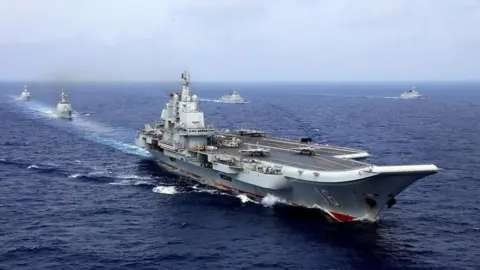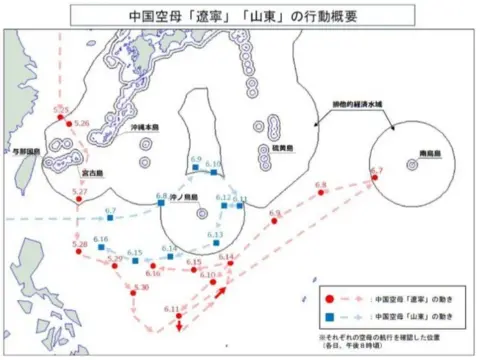Chinese navy drill near Japan sparks concern and protest
 Reuters
ReutersA Chinese naval drill near Japan has sparked concern from Tokyo, which in recent days lodged a protest with Beijing and made the rare decision to publicly disclose Chinese military movements.
In the last few weeks China's two aircraft carriers, the Shandong and the Liaoning, have been conducting simultaneous drills in the Pacific, in an unprecedented move.
Chinese fighter jets have done hundreds of landings and take-offs from the carriers. A few came close to Japanese surveillance planes, prompting Tokyo to convey its "serious concerns" to Beijing.
China has said its activities are consistent with international law and accused Japan of conducting "dangerous moves".
On Tuesday, the Japanese defence ministry released a map tracing the Chinese aircraft carriers' daily positions since 25 May. Japan does not usually disclose details of foreign militaries' movements.
It shows both carriers coming close to Japanese islands, and at times sailing through Japan's exclusive economic zone.
The exclusive economic zone is an area beyond a country's territorial waters where that country has exclusive rights to explore and exploit marine resources, but other countries are allowed freedom of navigation through it.
The map also shows the Liaoning sailing past the "second island chain", a line of defence outlined in US foreign policy doctrine that connects Japan to Guam. This makes it the first Chinese aircraft carrier to do so , according to Japanese news outlets.
Japan's defence ministry also said they had observed more than 500 landings and take-offs of Chinese fighter jets and helicopters during the drills.
On 7 June, a Chinese fighter jet took off from the Shandong and followed a Japanese surveillance aircraft for about 40 minutes, according to Tokyo. The next day, a Chinese fighter jet flew close to a Japanese plane for twice that duration, and crossed in front of it.
Japan's chief cabinet secretary Yoshimasa Hayashi said last week that they relayed to Beijing their concern about these "abnormal approaches" which could have caused accidental collisions.
Chinese foreign ministry spokesman Lin Jian said that their "activities in relevant waters and air space are consistent with international law and international practices", and that the two countries were communicating through existing channels.
"Let me point out that it is the close-in reconnaissance of Japan's vessels and airplanes on China's normal military activities that has caused maritime and air security risks. China urges Japan to stop those dangerous moves," he said.
 Japan Defence Ministry
Japan Defence MinistryAs its two carriers continue to sail through the Pacific, China's military gave an update on Tuesday on its newest carrier, the Fujian. It said sea trials were on track and the carrier is expected to enter service later this year.
The Fujian will be their first carrier that will employ electromagnetic catapults to launch their planes - a technology that currently only American aircraft carriers possess.
The technology allows a carrier to launch a wider range of aircraft, and launch fighter jets much faster.
China's fighter jets will also be able to take off with their full fuel and weapon loads from the Fujian, noted a Global Times report, and the carrier would enable a "significantly higher" number of sorties compared to its predecessors.
This month's drill follows February's much-scrutinised naval exercise in the Tasman Sea that prompted concern from Australia and New Zealand.
Canberra and Wellington had complained Beijing had given insufficient notice of the drill, and some commercial planes had to be diverted last minute.
Australia's defence minister Richard Marles later acknowledged that the naval exercise was in accordance with international law, while at the same time urging China to be more transparent about the reasons for what he called an "extraordinary military build-up".
China's latest moves come as the US promises to maintain its presence in the Indo-Pacific while balancing other commitments.
Last month US Defence Secretary Pete Hegseth emphasised the US's solidarity with the region, saying the US would not be pushed out of Asia nor allow its allies to be intimidated. China in response accused the US of being the "biggest troublemaker" in Asia.
But on Monday the US aircraft carrier USS Nimitz left the South China Sea. Multiple outlets have reported it is moving to the Middle East, as the war between Israel and Iran deepens and the US contemplates entering the conflict.
Kazuto Suzuki, a professor at the Graduate School of Public Policy at the University of Tokyo, said China's latest naval exercise was Beijing "testing the waters" of the US-Japan military alliance at a moment when the US is shifting its attention to the Middle East.
"With US assets concentrating in the Middle East, China sees this as an opportunity to escalate... so it's a sort of cunning way for China to raise the level of attention," he said.
This, he added, was "not an exponential, but step-by-step, gradual escalation" as it "seeks any holes in Japan's coastal and maritime defence... they are testing the patience of Japan."
